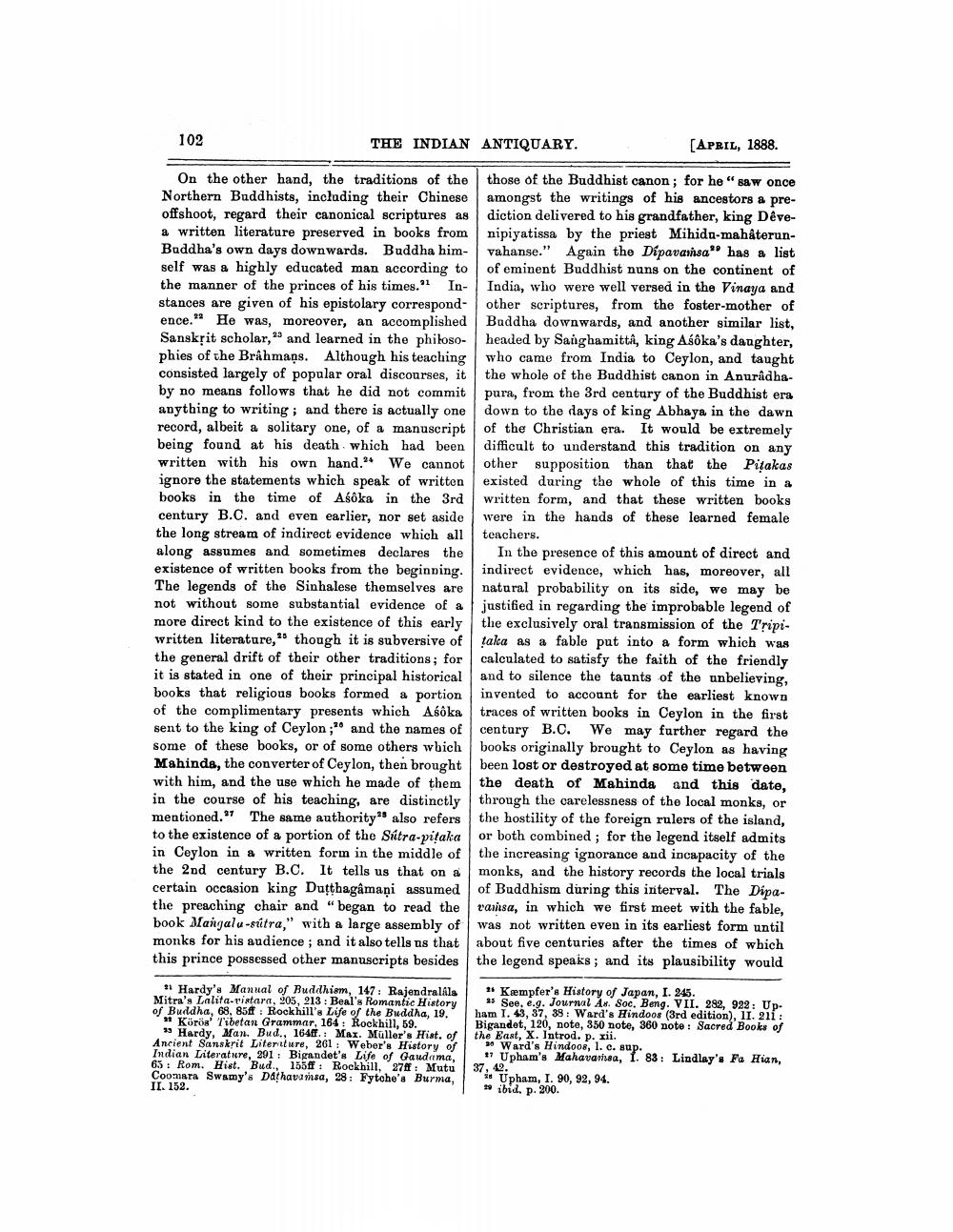________________
102
THE INDIAN ANTIQUARY.
[APRIL, 1888.
On the other hand, the traditions of the those of the Buddhist canon; for he saw once Northern Buddhists, including their Chinese amongst the writings of his ancestors a preoffshoot, regard their canonical scriptures as diction delivered to his grandfather, king Dêvea written literature preserved in books from nipiyatissa by the priest Mihida-mahåterunBuddha's own days downwards. Buddha him- vahanse." Again the Dipavasa" has a list self was a highly educated man according to of eminent Buddhist nuns on the continent of the manner of the princes of his times." In- India, who were well versed in the Vinaya and stances are given of his epistolary correspond- other scriptures, from the foster-mother of ence." He was, moreover, an accomplished Buddha downwards, and another similar list, Sanskrit scholar, " and learned in the philoso- headed by Sanghamitta, king Asôka's daughter, phies of the Brahmaņs. Although his teaching who came from India to Ceylon, and taught consisted largely of popular oral discourses, it the whole of the Buddhist canon in Anuradhaby no means follows that he did not commit pura, from the 3rd century of the Buddhist era anything to writing ; and there is actually one down to the days of king Abhaya in the dawn record, albeit a solitary one, of a manuscript of the Christian era. It would be extremely being found at his death which had been difficult to understand this tradition on any written with his own hand." We cannot other supposition than that the Pitakas ignore the statements which speak of written existed during the whole of this time in a books in the time of Asoka in the 3rd written form, and that these written books century B.C. and even earlier, nor set aside were in the hands of these learned female the long stream of indirect evidence which all teachers. along assumes and sometimes declares the In the presence of this amount of direct and existence of written books from the beginning. indirect evidence, which has, moreover, all The legends of the Sinhalese themselves are natural probability on its side, we may be not without some substantial evidence of a justified in regarding the improbable legend of more direct kind to the existence of this early the exclusively oral transmission of the Tripiwritten literature, though it is subversive of taka as a fable put into a form which was the general drift of their other traditions; for calculated to satisfy the faith of the friendly it is stated in one of their principal historical and to silence the taunts of the unbelieving, books that religious books formed a portion invented to account for the earliest known of the complimentary presents which Asoka traces of written books in Ceylon in the first sent to the king of Ceylon;" and the names of century B.C. We may further regard the some of these books, or of some others which books originally brought to Ceylon as having Mahinda, the converter of Ceylon, then brought been lost or destroyed at some time between with him, and the use which he made of them the death of Mahinda and this date, in the course of his teaching, are distinctly through the carelessness of the local monks, or mentioned." The same authority's also refers the hostility of the foreign rulers of the island, to the existence of a portion of the Satra-pitaka or both combined; for the legend itself admits in Ceylon in a written form in the middle of the increasing ignorance and incapacity of the the 2nd century B.C. It tells us that on a monks, and the history records the local trials certain occasion king Dutthagamaņi assumed of Buddhism during this interval. The Dipathe preaching chair and "began to read the ramsa, in which we first meet with the fable, book Mangalu-sútra," with a large assembly of was not written even in its earliest form until monks for his audience, and it also tells us that about five centuries after the times of which this prince possessed other manuscripts besides the legend speaks; and its plausibility would
1 Hardy's Manual of Buddhism, 147: Rajendralála Mitra's Lalita-ristara, 905, 213 : Beal's Romantic History of Buddha, 68, 854 : Rockhill's Life of the Buddha, 19.
» Köröz' Tibetan Grammar, 164: Rockhill, 69.
* Hardy, Man. Bud., 164ff.: Max. Mullor's Hist. of Ancient Sanskrit Literiture, 261: Weber's History of Indian Literature, 291: Bigandet's Life of Gaudima, 65 : Rom. Hist. Bud., 155ff : Rockhill, 27 Mutu Coomara Swamy's Dathavamsa, 28: Fytche's Burma, II. 152.
** Kæmpfer's History of Japan, I. 245.
25 See, e.g. Journal A. Soc. Beng. VII. 282, 922: Upham 1. 43, 37, 38: Ward's Hindoos (3rd edition), II. 211 : Bigandet, 120, note, 350 note, 360 note: Sacred Books of the East, X. Introd. p. xii.
30 Ward's Hindoos, 1. c. sup.
* Upham's Mahavanissa, 1. 83: Lindlay's Fa Hian, 37, 22. ** Upham, I. 90, 92, 94.
ibid. p. 300.




